Margaret Bugingo, University of Connecticut
Robert Zatryb, University of Connecticut
Abstract
In an effort to center multilingualism within academia and reshape our home institution’s preconceived notions and treatment of languages, peoples, and cultures, our writing center has worked to (1) implement multilingual tutoring practices, (2) increase audibility and comfortability for those of us who know and speak multiple languages, and (3) employ an anti-assimilative perspective that would foster appreciation for all languages. We want to share our approach in hopes of inspiring DEI initiatives that would build on work we’ve done in our own center and help build towards inclusive, anti-assimilative writing centers and universities nationwide.
Keywords: multilingual, writing centers, language
Introduction
Although many people in the U.S. are not monolingual English speakers, virtually all academic activities on U.S. college campuses, including instruction, research, and professional communication, take place only in English. This prevailing English-only reality devalues all other languages and establishes a hurtful language hierarchy that discourages people from actively using languages other than English. As a result, it creates power imbalances and limitations for multilingual speakers, and questions the purpose of learning multiple languages. Given that, we witness a need to hear languages other than English and normalize the presence of all languages in the U.S. academia. If all languages were audible, “able to be heard” (Cambridge University Press, n.d.) in U.S. academic spaces, it would help multilinguals thrive in academia by strengthening their social identities (Miller, 1999). By fostering the audibility of all languages, writing centers can contribute to dismantling prejudice against using languages other than English, and, as a result, contribute to linguistic justice. Up to date, much writing centre scholarship focuses on the importance of increasing translanguaging practices (Summers, 2020), but those centre on final products and outcomes in English. This article provides insights on how to centralise languages other than English within a writing centre setting.
In the context of writing centers, it could seem counterintuitive to need to verbalize language. However, if we dig into the baseline of the widely accepted peer-to-peer model of writing centers (Kail & Trimbur, 1987), we can draw the conclusion that in order for multilingual students to ensure they are meeting with a “peer,” they need to hear tutors, writing center staff, and other visitors actively use a variety of languages within the learning space. Anecdotal evidence suggests that access to tutors who are multilingual allows multilingual writers to feel more welcome and encourages a more active participation in the center. Simultaneously, increased exposure to languages other than English has the potential to motivate monolingual speakers to connect with multilingual individuals, finding inspiration to develop their own plurilingual skills and view language acquisition as a viable means of personal and professional enrichment. Only then can multilingualism find its rightful place and gain appreciation within public spaces in the U.S., particularly in academia.
We firmly believe that writing centers have a crucial role to play in advancing the value of multilingualism on university campuses. Beyond their function as venues for peer tutoring, writing centers serve as academic spaces where vibrant communities are forged (Fitzgerald, 2006), facilitating processes that promote social justice (Greenfield, 2019; Zimmerelli, 2015). This article analyses the struggles that multilinguals face in the U.S. academia and delves into how those struggles can be eased by bringing up the initiatives undertaken by the University of Connecticut’s writing center staff. We (Margaret, the Educational Program Coordinator, and Robert, the Graduate Assistant Director) joined the UConn Writing Center in August 2022. Driven by our own experiences in multilingual environments both in the U.S. and abroad, and conversations with multilingual tutors who worked in the writing center, we immediately started projects to enhance visibility and audibility of the linguistic diversity present on the UConn campus.
As we witnessed a need for the presence and acceptance of linguistic varieties in academia and as some linguistic varieties are natural for the authors of this piece, throughout this article we integrate linguistic varieties both in terms of language use (later on, you will notice our use of Spanish) as well as that of simple spelling shifts, such that, both British and American spellings of the same words will appear, as the authors each chose the variety that was most comfortable. The decision not to edit these spellings for consistency was intentional, as these variations represent the very real nature of our own linguistic diversity. Actions towards enhancing the visibility, but even more so, the audibility of all languages can be successfully implemented for example in writing centers. In particular, this article provides an overview of how we made different languages audible in the writing center space by educating staff members and faculty, implementing multilingual tutoring practices, and employing an anti-assimilative perspective that fosters appreciation for all languages. These actions created an environment that takes steps to welcome, empower, and value multilingual individuals.
Sociolinguistic context
In the United States, the phenomenon of multilingualism presents a dichotomy. On one hand, American households are witnessing a steady rise in multilingualism as a consequence of demographic shifts in recent decades. Presently, more than 20% of Americans speak a language other than English in their homes, a number that continues to grow (Gration, 2021). Walking down certain streets in the U.S., one can hear not only English but also español, 中文, polski, or Yoruba with equal frequency. Additionally, within the U.S. educational system, there exists a dearth of appreciation for multilingual skills. Over the past few years, over 600 world language programs have been shuttered at U.S. colleges, and a mere 7% of college students are enrolled in world language classes (Franks, 2019). This stark contrast sets the U.S. apart from most other educational settings worldwide, where the inability to speak more than one language is an anomaly, especially among the college-educated population. In the U.S., however, English monolingualism is perceived as the (desired) norm, a consequence of long-standing educational policies that prioritised (American) English over other languages and language varieties in schools and governments (Horner & Trimbur, 2002). This bias has led to the association of English with traits such as “educated,” “cultured,” and “American,” in contrast to any other language, creating a hierarchical view known as ‘linguistic imperialism’ (Phillipson, 1992). Researchers have demonstrated that languages other than English, when spoken publicly in the US, are read through a racialised and often racist lens—with white Americans in particular reacting negatively and even aggressively (Lee & Molina, 2021). Recordings of confrontations where individuals demand others to “speak English” in public settings under the pretence of “this is America” circulate widely across social media (Franscatore, 2021).
Consequently, multilinguals often feel compelled to conceal their proficiency in languages other than English to avoid stigmatisation. They find themselves embarrassed to utilise their full linguistic repertoire in public and default to English to blend in with the apparently monolingual majority. This tendency is particularly prevalent in academia, where the need to project a “professional” and “educated” image necessitates the use of academic General American English, often disregarding and devaluing other languages and linguistic variations (Greenfield & Rowan, 2011, p. 34). The academic expectation to perpetuate the use of General American English, also aptly termed White Mainstream English (Baker-Bell, 2020, p. 2), is rooted in privilege (Baker-Bell, 2020; Van Parijs, 2002, 2011). Languages other than English are still not seen as target languages, although they should be. Van Parijs (2002) in his work about linguistic justice identifies the disproportional worldwide advantage of English as “asymmetric[…]: the members of one linguistic group learn the language of another without the latter reciprocating. In such a situation, the cost of learning is borne by one group, whereas the benefit is enjoyed by both” (p. 59). This causes a further lack of “equal respect for the various languages with which different portions of the population concerned identify” (Van Parijs, 2011, p. 10).
Furthermore, in a globalised, multilingual world, the U.S.’s English monolingualism presents a clear cultural problem. Defaulting to English-only communication results in limitations when interacting with people from other countries and cultures. Relying on education and communication only in English harms the U.S. and its people politically, economically, and socially (Franks, 2019; Hopwood, 2018). Monolingualism diminishes opportunities of bonding and reduces mutual understanding (Hopwood, 2018). And this idealised monolingualism and downplaying multilingual abilities stems from the informal “ban” on other languages in U.S. public and academic settings. While the U.S. is an English-dominant territory, many languages are spoken and learned in the country, and each individual has the right and need to use all languages they know. By integrating linguistic justice for all languages within the U.S. academia, we contribute to the anti-discriminatory and antiracist work in which Baker-Bell (2020) grounds that term and to creating a more equitable educational system.
Our ultimate goal is to question English as a default and create an environment that would allow multilingual students to academically benefit from their multilingualism as well as foster a more equitable and valued reception of multilingualism. Whereas elsewhere in the world there are many examples of universities organising and supporting on-campus communication, oral and written, in different languages (see: Alvarez Valencia & Miranda, 2022; Gyenes, 2016; Herlihy-Mera, 2022), in the U.S. it is a rare case. In particular, those potential initiatives could empower domestic students who are heritage speakers of other languages, and lack confidence in switching to the other language in professional and academic settings, although they often have the linguistic skills to do so. Using multiple languages in educational settings (1) increases students’ recognition of the value that lies in linguistic diversity and in each language, (2) makes them aware of the political, social, and economic power structures that underlie language use, and (3) empowers them to exercise agency in making their own decisions about language use (Beaudrie, 2023). To accomplish these goals, we acted in three different areas: we created an educational offer for staff and community that thematised multilingualism, its benefits and challenges; we formally incorporated multilingual tutoring practises into our writing center; and we created a linguistically welcoming physical space.
How It All Began: from the UConn Writing Center Diary
Margaret Bugingo:
A conversation with a writing tutor regarding her honors thesis revitalized my efforts to centralize multilingualism in U.S. writing centers, a focus that had taken a back seat during some Fulbright work in Rwanda. To maintain the integrity of the original conversation, this reflection is written in Spanish.
Lizzette Irizarry, en ese momento una tutora de pregrado y yo comenzamos a hablar en español cuando la escuche a ella hablando en español, y le pregunté si esta bien si a veces voy a participar con ella en español porque me encanta el idioma1. Ella me dijo que, por supuesto, pero también me dijo que a veces es incómodo para ella cuando habla en español en la escuela y otros lugares públicos. Aunque a ella le encanta usar el idioma con personas conocidas, cuando ellos quieren. En una conversación ella me dijo que su investigación de honores se centró en un estudio de estudiantes bilingües y educación bilingüe. Cuando sugerí que ella use dos idiomas en su tesis, especialmente si ella quiere incluir cualquier narrativa partes, ella aceptó con entusiasmo, pero sugerí preguntar si su comité lo permitiría. Para mí, esta aprehensión fue triste– pues su escritura y su identidad es bilingüe, por que ella no puede a usar dos idiomas en su tesis?
As a writing instructor, I had encouraged multilingual writers to use all languages that were comfortable for them, as long as conclusions were in English and direct quotes were in the language put forth by the speaker/author. Reflecting on the past and further sparked by this conversation with Lizzette, I proposed that she and I work on writing center research geared towards better supporting multilinguals and make intentional moves to center the use of all languages and language varieties in our space. Robert Zatryb, a multilingual graduate assistant and co-author of this piece, and Eunice Kim, another undergraduate tutor, both of whom spoke and valued Spanish also agreed to work on initiatives in our space and later to present at the NEWCA conference. We each reviewed current research and took on different initiatives to make changes in our writing center. (Note: Lizzette and Eunice had time constraints during the time this article was due, such that they felt they could not contribute. However, you will see references to them and their work, as the integration of these initiatives was a team effort).
Robert Zatryb:
Cuando comencé a trabajar en el centro de escritura, me di cuenta de que había personas que hablaban otros idiomas, los cuales también dominaba. En particular, había varios hispanoparlantes y una tutora que hablaba alemán. Como tenía fluidez en ambos idiomas, empecé a hablarles a mis nuevas colegas en español y alemán. Al principio, ellas no se sentían del todo cómodas, pero con el tiempo fueron ganando confianza y establecimos una práctica diaria de comunicación en idiomas distintos al inglés. Sin embargo, lo más interesante no fue sólo establecer la comunicación oral, sino también la escrita.
Recuerdo el primer correo electrónico que le envié a Lizzette Irizarry, una de nuestras tutoras hispanohablantes. Como siempre nos habíamos comunicado en español, decidí enviarle el correo en ese mismo idioma, ya que me parecía lo más lógico y natural. Sin embargo, para ella recibir este correo fue algo significativo y empoderador, ya que era la primera vez que Lizzette Irizarry recibía una comunicación escrita, de carácter profesional y académico, en español, que para ella era un idioma casero y de familia.
It is important to realise and demonstrate that all languages can be used for professional, academic, and scientific purposes. The decision to include another language in this particular article was intentional, first, as it respected the integrity of the interactions to which we are referring; second, because both authors love, value, and actively use the Spanish language in our writing center; and third, because this is an article on linguistic justice, where languages other than English can and should be included. For most multilingual people, being limited to using only one language is like swimming using only legs: yes, it can be done, but they will swim much more effectively and comfortably if they also use their arms. In each language different things can occur to multilinguals—other ideas, different arguments, and their own logic arises. Since the academy involves an exchange of ideas, the education system should ensure that everyone has the opportunity to express themselves in the language or dialect they choose, as long as the message can be understood by the audience. Embracing and cherishing multilingualism will result in fostering a friendlier and more effective learning environment, developing stronger bonds among the community members, and embodying DEI ideals.
Language Equality and Linguistic Discrimination
Prior to Robert and Margaret’s time at UConn, in 2021, the administrative staff completed a work titled Conversations from the Margins (University of Connecticut, 2021), a component of a larger project, Racism in the Margins, which provided a jumping off point for initiatives detailed in this text, and as such, will be referenced throughout. This project included detailed video narratives from recently graduated writing center tutors that identified discrimination based on race and language and is currently a required read for all graduate students who are assigned to teach writing-intensive courses across the disciplines. In one such narrative, Odia speaks to the difficulty of being a writing center tutor witnessing inequality: “I’ve seen people cry in front of me reading their instructor’s comments or just being so confused and flustered that they just, emotionally—there’s a lot of spillage. I think at least twice a year, I’ve seen that happen” (3:06) and later identifies, “Racism has really given the impression that only white people have academic thoughts… or good thoughts” (5:34). Baker-Bell’s (2020) work on antiracism situates linguistic justice as a “call to action, a call to radically imagine and create a world free of anti-blackness” (p. 3). It is important for us to remember that “people’s language experiences are not separate from their racial experiences” (Baker-Bell, 2020, p. 2) as we work to address the need for linguistic diversity and linguistic justice within educational spaces. Perpetuating an English-centric system contradicts initiatives towards antiracism. Practices that favor monolingualism and imply expectations of such are in fact not only discriminatory but also racist in nature.
To channel and implement our own call to action, we reflected on the limitations of the systems in place in universities around the United States as well as additional theory like that of Greenfield’s call to restructure writing centers into what she calls radical writing centers. Greenfield (2019) claims:
A radical writing center does not necessarily stop offering individualized instruction (though it might) but rather exceeds individualized student instruction as its sole method of educating for change. A radical writing center recognizes that everyone who stands in relationship to it has both the agency and the ethical responsibility to work towards change. That means individual students who want to improve their writing are not the only ones with work to do. Classroom teachers, administrators, staff, students who never step foot into our physical space, and even alumni and members of the surrounding community can be engaged by the writing center in a process of resistance. (p. 118)
This process of resistance to which Greenfield calls upon us to contribute needs to be grounded in antiracist moves, calling upon each writing center and surrounding staff, faculty, students, and especially administration, to make tangible changes to the physical education spaces as well as the policies and programs at play at the institution to invite more multilingualism and multiculturalism.
Another narrative from the Conversations from the Margins video details the experience of Annelise, a tutor who worked with a multilingual student who received ineffective feedback on a final paper from a professor: “So, basically all it said was — in red pen—which I know is really scary for people… “C” and like a circle and it said “it looks like you’re still having trouble with English… visit the Writing Center” (0:38). Experiences like this, with the not so subtle “visit the writing center,” direction, remind us that the larger institutional structure often plays in tension with any DEI and progressive work writing centers hope to complete and often these larger structures shape the negative ways individuals first enter and understand the writing center and writing center work. Reflecting on these tensions pushed us to channel Greenfield’s ideas centered on engaging the whole community of our university. These efforts are still in process, particularly when it comes to faculty.
Kat, another former UConn tutor who contributed to Conversations from the Margins, experienced push back in her own multilingual work when she was told, “You can’t start a statement with, you know, some Spanish words” (1:28). In her video reflection, Kat noted that this not only attacked her language, but her culture, while alluding to issues of language superiority. In previous work, Greenfield and Rowan (2011) challenge language superiority, noting, “This belief [that some languages are superior to others] is perhaps the most fundamental false premise upon which racist arguments are built” (p. 35) and emphasises that such notions perpetuate linguistic discrimination and hinder the support provided to multilingual students. In order to commit to undoing racism, writing center staff and tutors need to “recognize and celebrate multicultural norms and practices, and distinct cultural backgrounds and norms” (qtd. in Condon, 2007, p. 24) but to do so in a way that makes social justice work actionable and practical (Basta, 2020). Condon (2007) shares that it is crucial for directors and tutors in the writing center to work together to “understand the ways in which learning, knowing, and representing knowledge are culturally situated” (p. 24). Further, the work of Del Russo et al. (2020) calls upon us to embrace translingualism where they note that diverse thinking, speaking, and writing can add to our repertoires, claiming: “When we expand tutoring and writing opportunities to recognize and make use of the full spectrum of meaning-making resources, across languages and modalities, we are better prepared to support our diverse student populations” (para. 11). This diversification focus was a necessary lens through which we could actively build a writing center that is more audibly non-white, non-monolingual in structure.
It would be an impossible expectation for those who teach and tutor in U.S. academic spaces to somehow adopt and instruct in languages and cultural writing norms with which they’re unfamiliar. For many tutors, this is not a priority given the limited amount of time universities already have to disseminate content to students, but that does not negate the need for identity development. For example, when Kat was discouraged from using Spanish in her work, she was told, “You can’t use that because you don’t know if the people who are reading this know Spanish so they’re not gonna know what you are saying” (1:28). However, the restricted use of language discourages her development of identity through the variety of languages in her repertoire.
And while writing center tutors often feel the need to walk a fine line between helping students get an “A” or helping them to develop their writerly identities (Del Russo et al., 2020), writing centers are singularly well-positioned to assist writers in developing their writing knowledge and skills through their identities. Identity development through writing is a widespread and accepted theory (Adler-Kassner & Wardle, 2015) and given that writing centers are a “hub for international and multilingual students, where culture, ideology, and language diversity take center stage” (Blazer & Fallon, 2020, para. 6), writing centers are well-positioned to encourage individual identity development through writing (and speaking) and to do so in a way that still encourages a clear message is communicated to all audiences.
Drawing from Grimm (2011), we recognize that “the policies and practices of a particular writing center can either encourage or discourage the process of developing an identity of belonging to an academic community” (p. 96). Thus, “If a community of practice wants to encourage learning, it must focus on ways to increase opportunities for participation” (Grimm, 2011, p. 96). To encourage learning at our own institution, we emphasize the need for the writing center to understand and celebrate multicultural norms and practices, promoting an inclusive environment where all writers’ cultural backgrounds are recognized.
Strategies for Supporting Multilingual Writers
Leki (2007) identifies three groups of multilingual writers visiting the writing center: international graduate students, international undergraduate students, and domestic students who immigrated earlier in their lives. Interestingly, one group that Leki does not list among multilinguals are domestic students who grew up speaking English, yet became multilingual later in their lives, for example through world language education and/or extensive time abroad. It also downplays the multilingual skills of the English-dominant population. One can argue that it is because those individuals do not need an extra support in the writing center, but that perspective aligns all too well with the old, hurtful image of multilingualism that equates to a deficit in English.
The general advice Leki gives about working with each group has been a great help in our daily practice at the UConn writing center. Our tutors, when confronted with Leki’s text, saw how the writers they meet at the writing center align with Leki’s categories and found it useful to understand different needs of multilingual writers. Yet, they also found the linguistic backgrounds of many students are much more complicated than this simple classification. To better understand writers’ needs, universities, including ours, often survey writers about their linguistic backgrounds. This can indeed help create instruments of support, but it also delivers an oversimplified picture of what they can (or cannot) do in a certain language and how their spoken languages do or do not interfere with each other (Lorimer Leonard et al., 2021). To better tailor our support for each student, it is imperative to ask them in the writing session about their linguistic backgrounds and preferences, and what they need and how they want to approach their multilingualism when working on a piece.
Educators often try to erase racism and discrimination by changing labels to intentionally non-harmful ones, for example using the term “multilingual writers” instead of English Language Learners or Second Language Learners (Snyder et al., 2023; Vieira, 2017). However, this does not solve the problem of negative perception because the same multilingual students are still perceived as carrying a deficit. It would be wise to include English-dominant multilinguals under the term “multilingual” to embrace and cherish their skills as well as the“imperfections” and “deficits” that they might have in languages other than English. Centering on English learners’ efforts to learn the language and ignoring the fact that many first language (L1) English speakers also learn and speak other languages contributes to linguistic imperialism and creates a language hierarchy that centralises English, because it suggests that English L1 speakers do not need to speak another language, and if they do, it’s a positive association, somehow far removed from the term “multilingualism”. If we wish to value multilingualism, as is often espoused in various DEI initiatives and writing circles, we should value the multilingualism of all, and if this was the case, “wouldn’t everybody be learnin’ everybody’s dialect? Wouldn’t we all become multidialectical and pluralingal”? (Young, 2010, p. 63). It is imprescindible to understand that all languages are worth learning and that all people, no matter what their first language is, should learn at least one other language (Kroll & Dussias, 2017). Acknowledging and recognizing English-dominant speakers who have some fluency in other languages as multilinguals as much as those who speak English as a second, third, or fourth language would help create a more democratic, egalitarian image of multilingualism.
Often, domestic English-dominant writing tutors or multi-dominant writing tutors (those we would define as equally proficient in English and another language) who speak other languages prefer to stick to English in their roles as tutors, students, and scholars. They are often afraid of exposing any “deficits” and “imperfections,” since they are conditioned to doing everything professional and academic in English. The former also often fears appropriation of the term multilingual. And as they are in a space of privilege to be tested and graded in a language that is native for them, that privilege allows them more comfort. Unlike their peers dominant in languages other than English, they are not often forced to confront their fears or limitations. In order to become more empathetic, we have created tutor education (described in detail in the next section) that supports peer tutors in becoming open to cultural and linguistic otherness, coming out of their linguistic comfort zones, and giving the opportunity to engage in professional and academic discourses in other languages.
Collaborating with Staff and Community on Multilingualism
Tutors’ skills, beliefs, and knowledge about multilingualism is the essence of writing centres’ day-to-day operations, therefore tutor education is an essential first step that underlies all changes towards social and linguistic justice (Basta, 2020). Besides the ethical and theoretical questions of multilingualism, in our staff workshops we also focused on specific tutoring strategies that might be helpful in working with multilingual individuals. We collectively elaborated a set of advice to work with multilingual students that includes serving as a cultural informant, encouraging translanguaging (Otheguy et al., 2015) strategies, allowing the tutee to choose between lexical items, and addressing lower-order concerns, without simply editing. At the same time, the tutor has to keep in mind that the population of multilingual persons is very diverse and each one of them will have different expectations and needs.
Anderson (2020) identifies a discrepancy between the general training and guidance that the tutors receive, and multilingual (especially international) writers’ expectations from a tutoring session. Tutors usually tend to put stress on higher-order concerns, such as organisation of the piece, argumentation, and genre conventions, whereas international multilingual tutees usually want more help with grammar and lexical accuracy, which is a result of multilingual students’ insecurities about their English language skills. Those insecurities are sometimes reinforced by faculty in college classrooms (Zatryb, 2023) as we see in some of the narratives from Conversations from the Margins. For example, Yasmine shares: “It was one of those papers where the professor just tries and corrects all of the grammar, and it’s covered in pen… of different colors from multiple times of getting it back and sending it back over. And so she’s in tears, and essentially like one of the comments, and what he told her to do is “go to the Writing Center to learn English” (1:02).
International students’ fixation on grammar and linguistic accuracy goes against the training that tutors usually receive but is often in tandem with the feedback they receive from their professors, as we see in Yasmine’s narrative. Progressive language policies practised in most writing centers should acknowledge (international) students’ wish to enhance and develop their linguistic proficiency (in English and in other languages). This linguistic development might include conforming to certain linguistic standards and altering students’ default linguistic choices (Summers, 2020). Some tutors, especially those coming from areas different to linguistics, doubt if they are capable of meeting multilingual international students’ needs. To fill this gap, to build on the momentum of a linguistic justice statement that staff had crafted a few years earlier (see Figure 1), and to sensitise the University of Connecticut’s writing center staff to the challenges and limitations that multilinguals face in the U.S. academia, we conducted a series of workshops about multilingualism and linguistic justice (Baker-Bell, 2020; Van Parijs, 2011) in our monthly meetings.
Figure 1
Image Showing the Most Recent Iteration of the Writing Center’s Linguistic Justice Statement
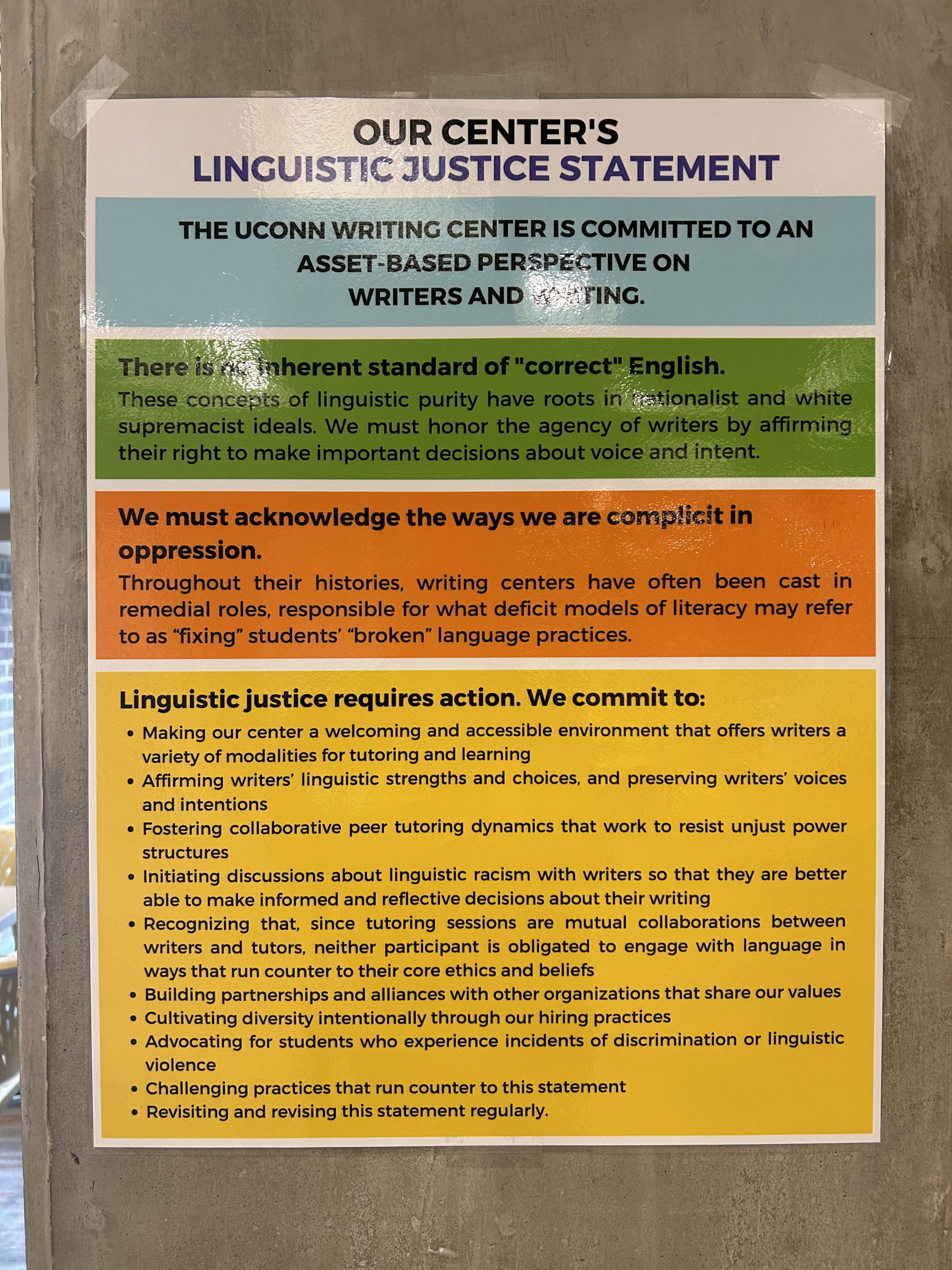
To question the English-only norms of U.S. academia, we began training our own staff, beginning the workshop with a short and simple 5-minute written assignment that needed to be completed in any language other than English. This exercise elicited varying responses. Some of the tutors, fluent in other languages, had no problems with the task, some others had little knowledge of other languages and struggled with the activity, and there were also few complete monolinguals that could not write anything. This sparked a discussion about multilingualism being not a deficit, but rather an advantage. Those who could not complete the task at all showed the limitations of a monolingual person. Multilinguals, on the other hand, can communicate their thoughts in multiple languages, which allows them to reach different audiences.
Further, we explored the concept of World Englishes (Mesthrie & Bhatt, 2008) and questioned why, in a widely globalised and internationalised setting, we are forced to adhere to the General American English in U.S. academia (Matsuda & Matsuda, 2010). We educated the staff about different spellings, lexical and grammatical differences between linguistic varieties, touching upon the question of register. Tutors’ awareness about language ideologies helps them better serve multilingual writers (Blazer & Fallon, 2020). Especially important is to acknowledge and recognise those differences in the tutoring sessions, because erasing certain elements of writers’ idiolects and dialects might take away their unique voices and the richness of their identities. On the other hand, tutors also have to be aware of the genre specifics and conventions of each piece of writing and their audience. They have to skillfully navigate and negotiate between the writer’s identity and the expectations of the audience. This translingual rhetoric needs deep mutual understanding (Wang, 2018).
We expanded our workshops, initially conducted only for our writing center staff, to other audiences—in Fall 2022, Robert and undergraduate tutor Eunice conducted an adjusted workshop about respecting dialects and multilingualism for high school students building or already participating in high school writing centers throughout Connecticut (see Figure 2). This workshop drew a small number of attendees, mainly monolingual English speakers, which opened up conversations that many attendees had not yet thought about but also limited the discussion as these individuals had not personally experienced or witnessed the experiences of multilingual writers. However, in Fall 2023, retitled, “Multilingualism is a Superpower,” the workshop was wall to wall with attendees—boasting the largest workshop at the conference—many of whom identified as multilingual, fluent in languages such as Spanish, Russian, Turkish, and Korean. The discussion that ensued regarding embracing multilingual speakers was also much more fruitful, wherein attendees identified personal experiences of embarrassment or fear associated with foreign language use in academia but an interest in further developing their confidence in utilising all of their languages. We believe retitling the workshop may have played a role in the attendance.
Figure 2
Photo of the “Respecting Dialects and Multilingualism” Workshop for High School Writing Centers and Tutors
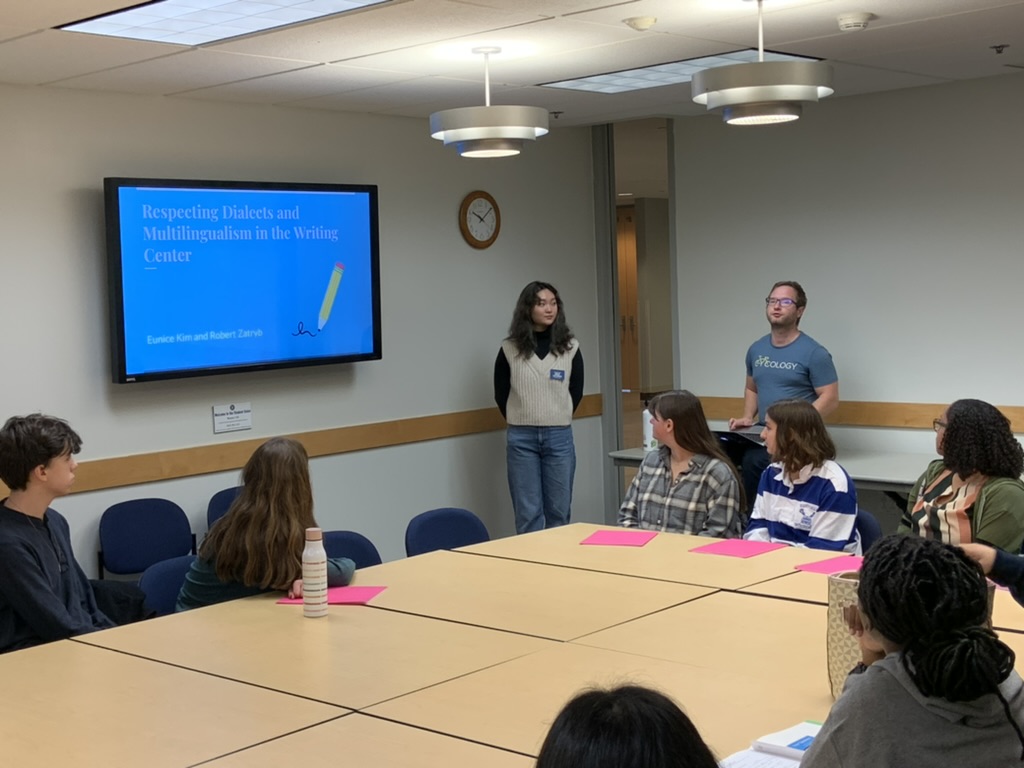
Later, channeling Greenfield’s call to engage faculty and staff in efforts of resistance, Margaret and Robert led a workshop on effective and non-discriminatory ways of working with multilingual students for a group of graduate and faculty instructors. One of the difficulties we faced in this workshop was combating the continuing narrative that writing centers are an “editing shop” that students go to to “learn English” as many of the narratives in Conversations from the Margins alludes to, and further, that our job is to fix the “grammar” for these students. Thus, the workshop shared suggestions for faculty including, acknowledgement that writing might be syntactically “correct” despite not being colloquially “common”; acknowledgement that editing feedback should be limited to a paragraph at a time or 3-4 rules focused heavily on clarity of understanding rather than stylistic choice; and the awareness of the needs and difficulties that often face multilingual students, particularly undergraduates. The discussion that ensued offered an open dialogue where instructors could address questions and concerns they had regarding expectations for students to read, comprehend, speak, and write in the same manner as English monolinguals, as well as a discussion on the lack of equity surrounding those expectations.
Following this workshop, one “radical” institutional policy change the authors would like to propose regards time limitations on tests and whether or not multilinguals should qualify for additional time, allowing them to comprehend questions and respond in an equitable amount of time. Additional workshops to address similar discussions and concerns were requested. However, currently, the main barrier is that the majority of faculty we reach are multilingual themselves or are already engaged in practices designed to best support multilingual students, so one future goal is to broaden our scope of influence.
Multilingual Tutoring Practises in Writing Centers
To focus more intentionally on writers who might prefer to speak another language while working on writing in English, we encouraged all tutors who were willing to use their proficiency in languages other than English in their tutoring sessions to share their language skills in their tutoring bios so that visiting writers might become more familiar with the languages we speak. For the 2022-2023 year, we were able to offer writing tutorials in American Sign Language, Cantonese, Spanish, Turkish, Polish, German, Russian, Korean, and French. Students visiting the center this year opted to work with tutors in Korean, French, German, Polish, Mandarin (which one tutor decided he felt moderately comfortable tutoring in), and Spanish. Moving forward, we hope our efforts to amplify the audibility of languages will assist in increasing the number of languages offered as well as the awareness of these services and the comfortability of writers to request these services. One challenge we often encountered was lack of institutional awareness as well as lack of comfort for writers to request languages other than English; however, as we have verbalized this work more and more, we are finding more interest and awareness campus-wide. Additionally, in February 2024, we made the decision to share language abilities on our scheduling platform such that writers could choose a tutor based on language (see Figure 3).
Figure 3
Photo of WCOnline Scheduler Depicting, in the Tutor Name Column, the Languages in which Writers can be Tutored
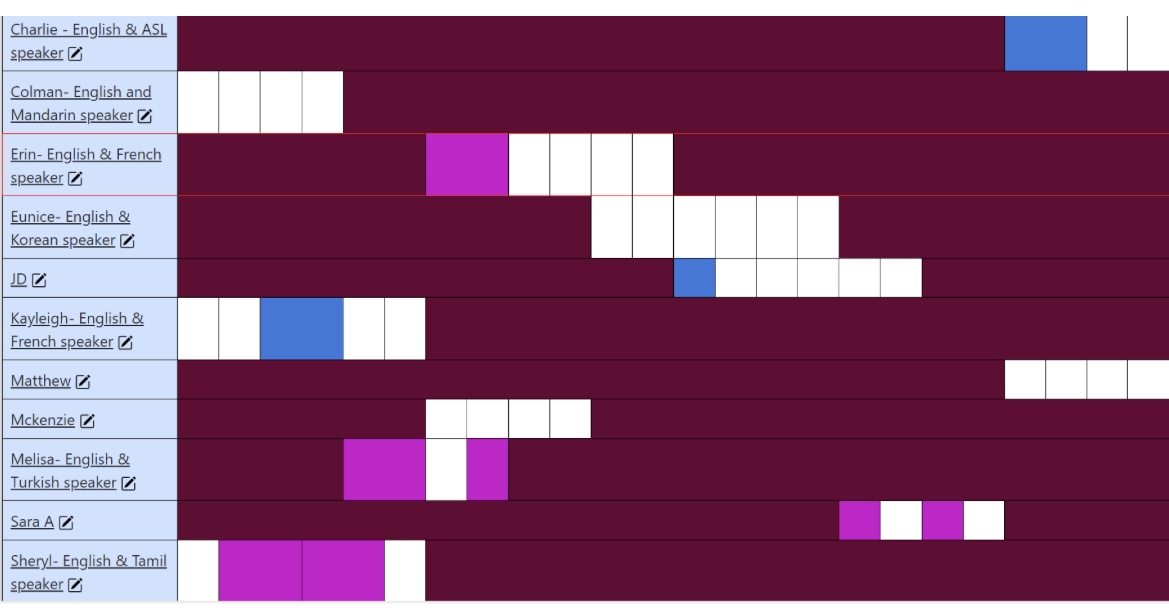
Since beginning this article, we have also created more cross-campus connections, one of which resulted in an invitation to speak to a group of graduate international students and over 100 undergraduate international students to personally welcome them to the writing center. This created an opportunity to discuss writing fears, comfortable languages, and all that the writing center has to offer. We are planning to track incoming writers to see if there is an increase in the number of international students visiting the center this year.
Beyond aiding multilingual writers in improving their writing in English, we sought to extend our support to communication in other languages, both oral and written as we wanted many languages to actually be heard in the writing center. Challenging English as a default and allowing other languages to take up space in our writing center created an increase in linguistic justice for all languages. To bridge the existing gaps in multilingual tutoring, Robert led the effort to formally integrate tutoring for languages other than English into our writing center. Inspired by Noreen Lape (2019), who established a Multilingual Writing Center at Dickinson College, we partnered with the Department of Literatures, Cultures, and Languages (LCL) at our institution, which already offered formal tutoring hours for students enrolled in their language classes. The sessions, mostly conducted by graduate students who were also language instructors, originally took place in their offices, functioning as regular office hours. However, we proposed that these tutoring hours be moved to the UConn writing centre space. Fortunately, some language tutors embraced our idea, and we successfully hosted tutoring sessions in German, French, Spanish, and Italian during the Spring Semester of 2023. This practice has continued into 2024. Others were not yet interested in changing the location of their tutoring to the writing center, but we hope to continue and expand this partnership moving forward. Figure 4 depicts a flyer that shares details about this service.
Figure 4
Image of German Language Tutoring Flyer
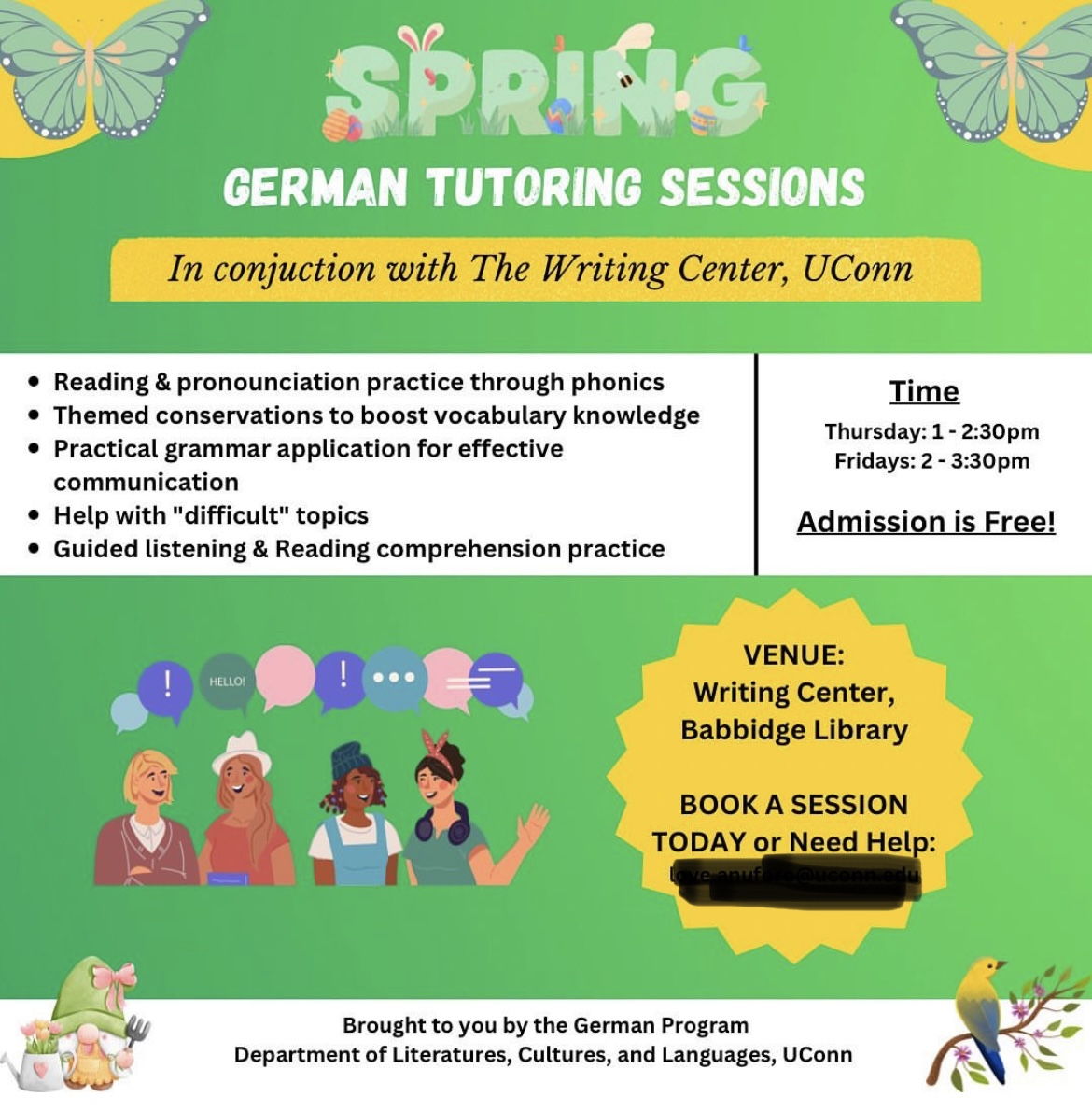
The writing center’s open and inviting setup, resembling a cafe, with several tables and chairs in the main library on campus, facilitated a more conversational and informal atmosphere for multilingual tutoring. This arrangement differed from the traditional one-on-one setting in the graduate students’ offices. Graduate tutors from the LCL department brought in their regulars from previous sessions, but to widely promote this new service, the administrative team advertised through various channels, including social media, campus posters, and campus newsletters. The response was overwhelmingly positive, as students from different departments, faculty members, and university staff expressed an interest in practising and improving their multilingual skills, and the tutors hosting these hours expressed appreciation for the welcoming community of the writing center as well as the interest in their sessions. For example, the German tutor noted to the authors that prior to tutoring in the writing center, the only students who visited her office hours to practise German were those who had already taken classes with her. Upon offering the same number of hours, but in the writing center, the tutor received additional students interested in learning German. It seemed the centralization in the writing center offered increased access and knowledge of this learning opportunity, something the tutor valued, as she felt her hours were used effectively and the language was reaching a larger population.
The process of collaboration with the Department of Literatures, Cultures, and Languages was facilitated by the presence of Robert in the writing center, who is a graduate student in that department and personally acquainted with the multilingual graduate tutors. Looking ahead, we plan to maintain this partnership and hope to expand the range of languages offered in our space. Additionally, we are considering the possibility of incorporating the multilingual tutors into our scheduler, thus streamlining the scheduling process. For now, tutors for languages other than English continue to manage their own scheduling.
Anti-Assimilation: Creating a Linguistically Welcoming Space
To combat some initial discussions of discomfort, we took practical measures to increase audibility and promote language diversity within the writing center. Small moves our team made to create a more visibly inviting writing center included sharing a large poster espousing our “linguistic justice statement;” a beautifully painted sign indicating “all languages are welcome (see Figure 10);” and a map documenting spaces where our tutors had lived (see Figure 5), alluding to languages they may have learned.
Figure 5
Map of the World with Tacks Tutors can Use to Show where they’ve Lived
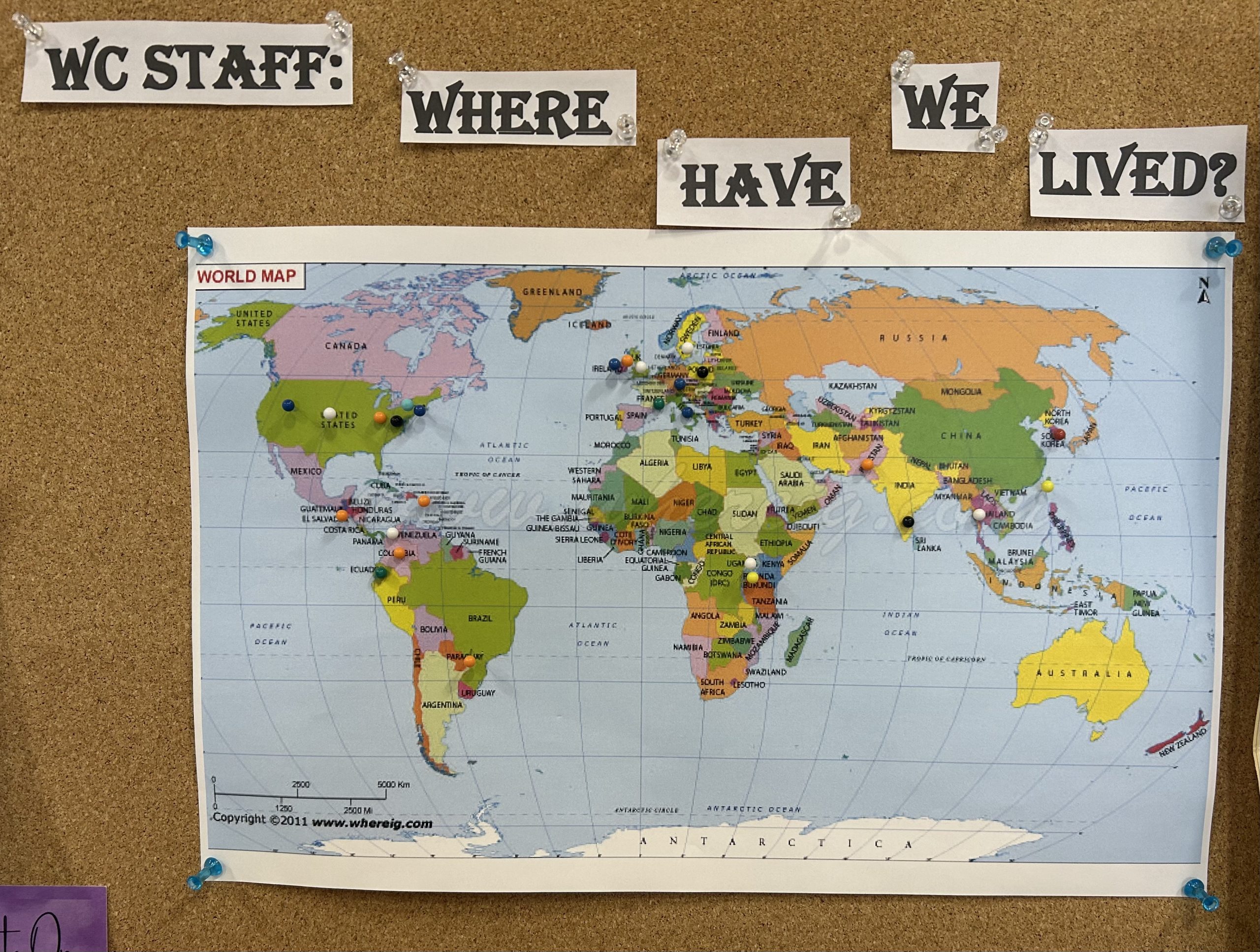
We also chose to have an interactive whiteboard in the space that shares the languages of the writing center and encourages visiting writers to “add theirs” (see Figure 6).
Figure 6
Interactive Whiteboard Depicting Languages Spoken by Writing Center Staff that Encourages Visiting Writers to “Add Theirs”
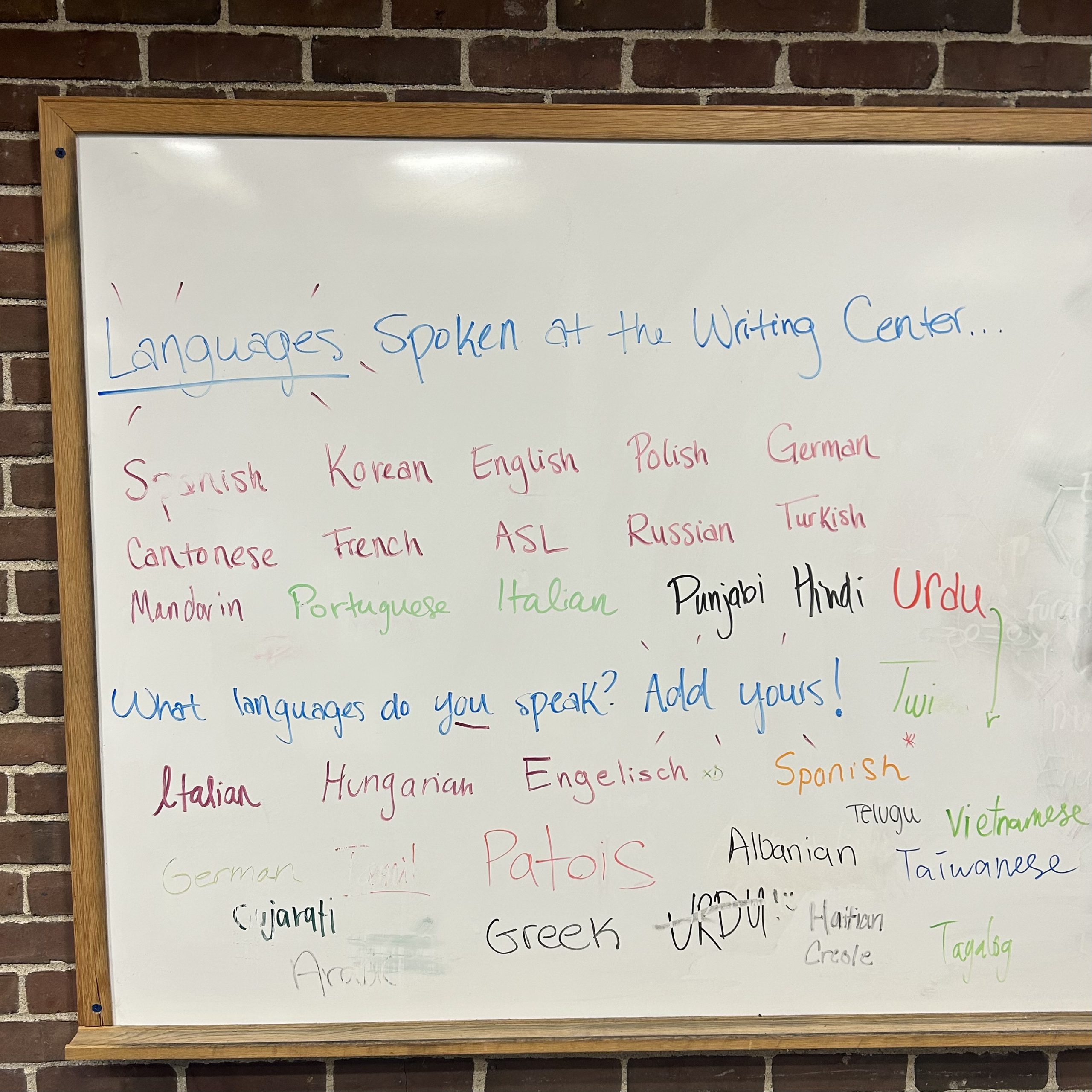
Additional initiatives included encouraging tutors to openly use their language repertoires such that at any time, you might walk into the writing center and overhear conversations casually being held in Spanish, Italian, Kinyarwanda, Polish, or French. Given that multiple administrators (including Margaret and Robert) were witnessed using languages other than English, undergraduate and other graduate tutors were encouraged to do the same. A subcomponent of this work included initiatives to welcome all writers into the center, beginning with small moves like adding candy to the center and opening up the center to a free morning coffee hour. Here, we began reaching writers who had not made moves to enter the center in the past, including multilingual students (at the first one, Margaret was thrilled to use her minimal Bosnian to connect with a first-time visiting student) as well as others who are historically less inclined to feel comfortable in writing centers. As members of the administrative team, we inquired as to the interest tutors had in sharing their language repertoires publicly and privately by surveying tutors with an anonymous questionnaire. This soft move created space for tutors to come forward to share their language skills on the website, on their nametags, and more, without feeling obligated. As much of the university system can see language diversity as a deficit, it was important for us to offer this option without requiring it.
To normalize and promote the use of languages other than English in the writing center space and foster a sense of belonging for both multilingual writers and staff members, we took the initiative to create a “multilingual coffee hour”. The goal was simply to expose the larger institution to languages other than English. As we held the event several times, it kept growing, and we welcomed not only European languages like Spanish, French and Polish, but also less commonly taught languages to open up the university community to a greater linguistic diversity. Here, we were able to incorporate, among others, Yoruba, Farsi, Turkish, and Karen (see Figures 7, 8 and 9).
Figure 7
A Visitor Learns Yoruba at the Multilingual Coffee Hour
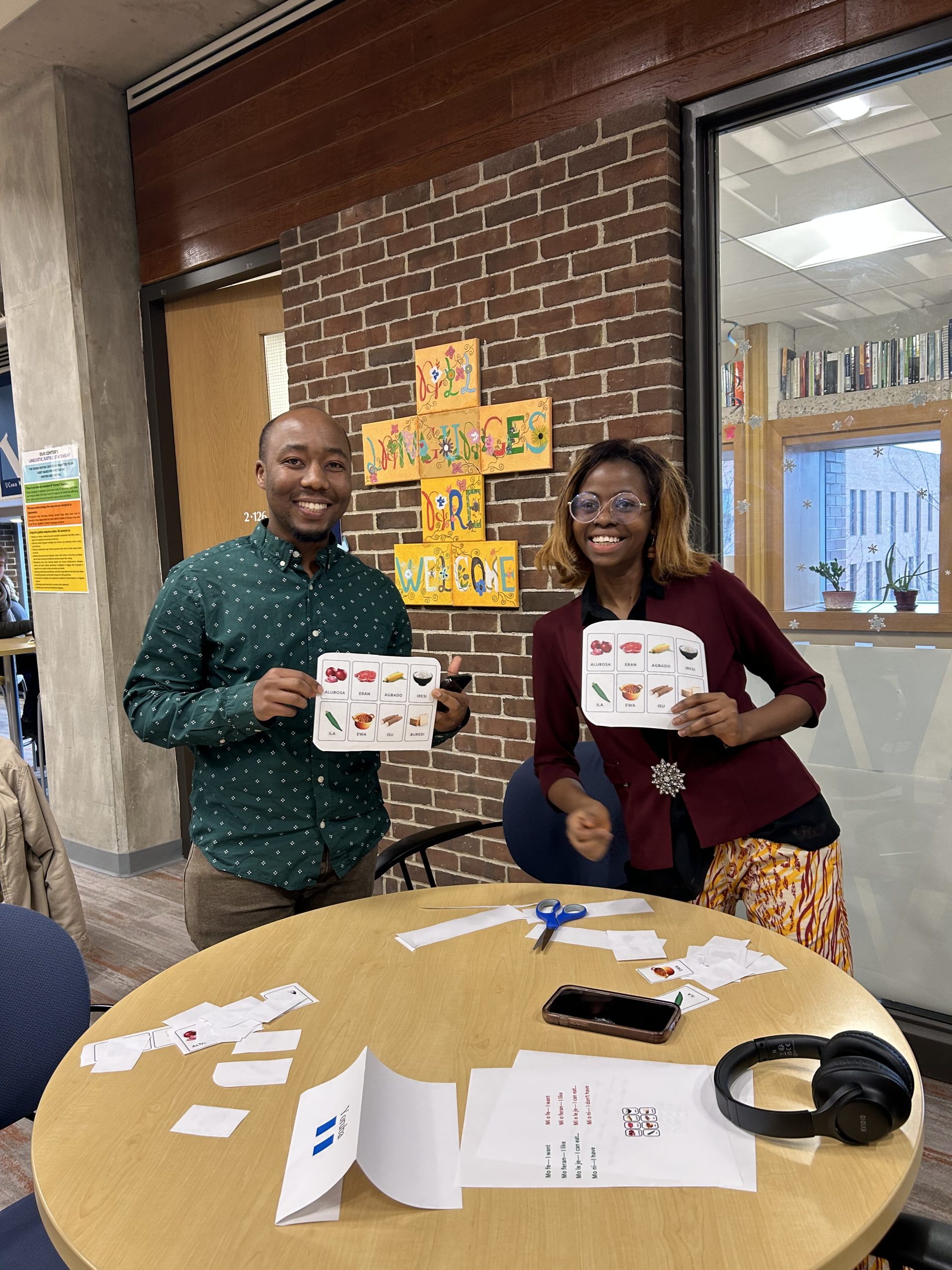
One of the inspirations for this initiative was a periodical event in which Robert participated when living in Bogotá, Colombia; another was an event Margaret helped host in Idaho, as a collaboration with the International Visitor Leadership Association. The former was called “¡Dame tu lengua!”2, and offered a space “(…) donde colombianos y extranjeros pueden reunirse y disfrutar de una deliciosa comida, además de tener un espacio cultural con intercambio de conocimientos y experiencias”3 (DeContacto, 2016). The latter invited dozens of international visitors from around the world to simultaneously host “cocktail” tables, decorated with their flags, to share culture and language with the larger Idaho community, all while enjoying some snacks.
Figure 8
Visitors Learn Hungarian at the Multilingual Coffee Hour
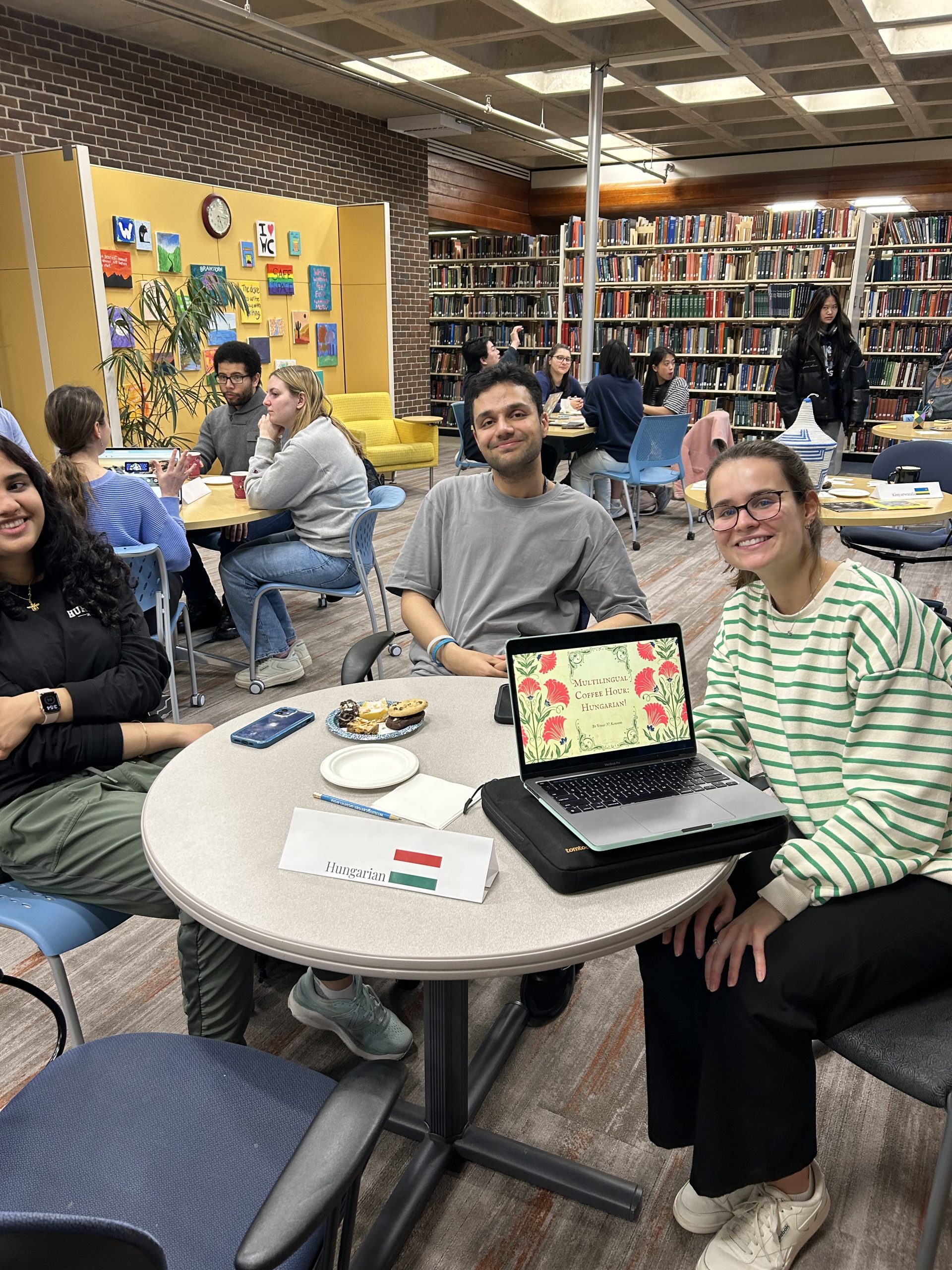
We combined these ideas and added in some new elements, creating opportunities for faculty, staff, and students to engage with many languages and cultures at the same time. We ordered food and coffee and welcomed visitors to individual tables wherein they could participate in a mini-lesson of each language, see photos from those communities, and learn about the cultures. At each table, one multilingual member of our community (among them members of the writing center administration and tutors, graduate tutors from LCL, and our friends and allies from all over campus) hosted a mini class of one language; visitors were then able to rotate between the tables and learn multiple languages in one event. We offered up to 15 languages per event (held 3 times in the 2023 spring semester, 3 times in the following fall, and once so far this spring) and drew crowds of upwards of 60 people interested in learning words and phrases in these languages.
Figure 9
Two Individuals Teach Kinyarwanda to Writing Center Visitors
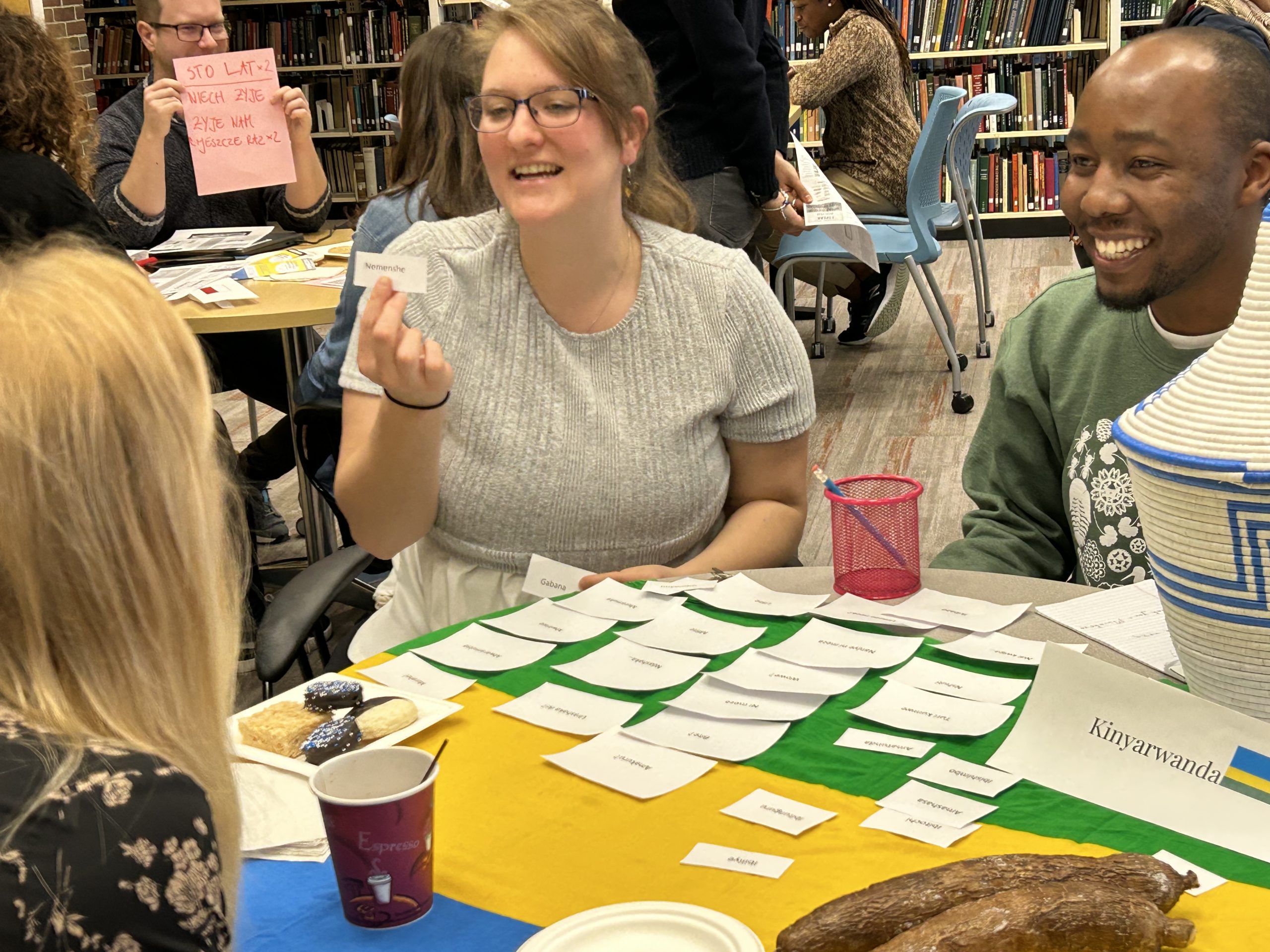
Interestingly, many of the visitors, drawn by the multilingual coffee hour, had never been to the writing center before. This was an excellent opportunity to inform everyone on campus about the work we do and centralize multilingualism as a core component of the writing center. Ultimately, we also began creating a community for ourselves and others who resonated with learning, speaking, and engaging in languages other than English.
One such way that we have added to our multilingual community is through hiring practices. Among a call for thoughtful and reflective students interested in tutoring, a blurb that went out to faculty also included the following language: “Additionally, we actively seek applicants who represent traditionally underrepresented groups. Students from diverse ethnic and racial backgrounds and/or who are multilingual are highly encouraged to apply.” After reviewing over 100 applicants and interviewing 30, we hired 10 new tutors, half of whom are proficient in at least one other language and were willing to use this language in tutorials with writers who so choose. Many who reached out to the writing center to inquire about a position cited the multilingual coffee hours or other efforts with multilingualism as a draw.
Conclusion and Future Directions
Reflecting on conversations with some wonderful writing center directors over the past few years, Margaret is reminded of a claim that almost all have made to her at some point or another: writing centers offer unique spaces of resistance that all administrators have become lucky enough to partake in. These spaces allow for “radical” change, even if we often fall short of these ambitions, and we would be remiss if we did not do our utmost to contribute to that change in effective ways. Community is an essential piece that writing centers can offer in effort towards change, and community is what many of us need in academia. For the University of Connecticut, that community was made even more possible by the writing center creating a space for audible language exposure as well as a learning space for those developing language and identity. Our center recognized the paradoxical coexistence of a multilingual American society with an anglocentric educational system that undervalues and stigmatizes languages other than English. But that anglocentric approach does not need to exist. Greenfield calls upon the “radical writing center [to] recognize that everyone who stands in relation to it has both the agency and the ethical responsibility to work towards change” (p. 118). This article has outlined our efforts to work towards change, to challenge the deficit and often racist association made with multilingualism and to create a linguistically welcoming environment within our writing center. A painting depicting “All languages are welcome” is now the first visual that welcomes incoming writers (see Figure 10).
Figure 10
Photo of the Painting “All Languages are Welcome” with the Artist
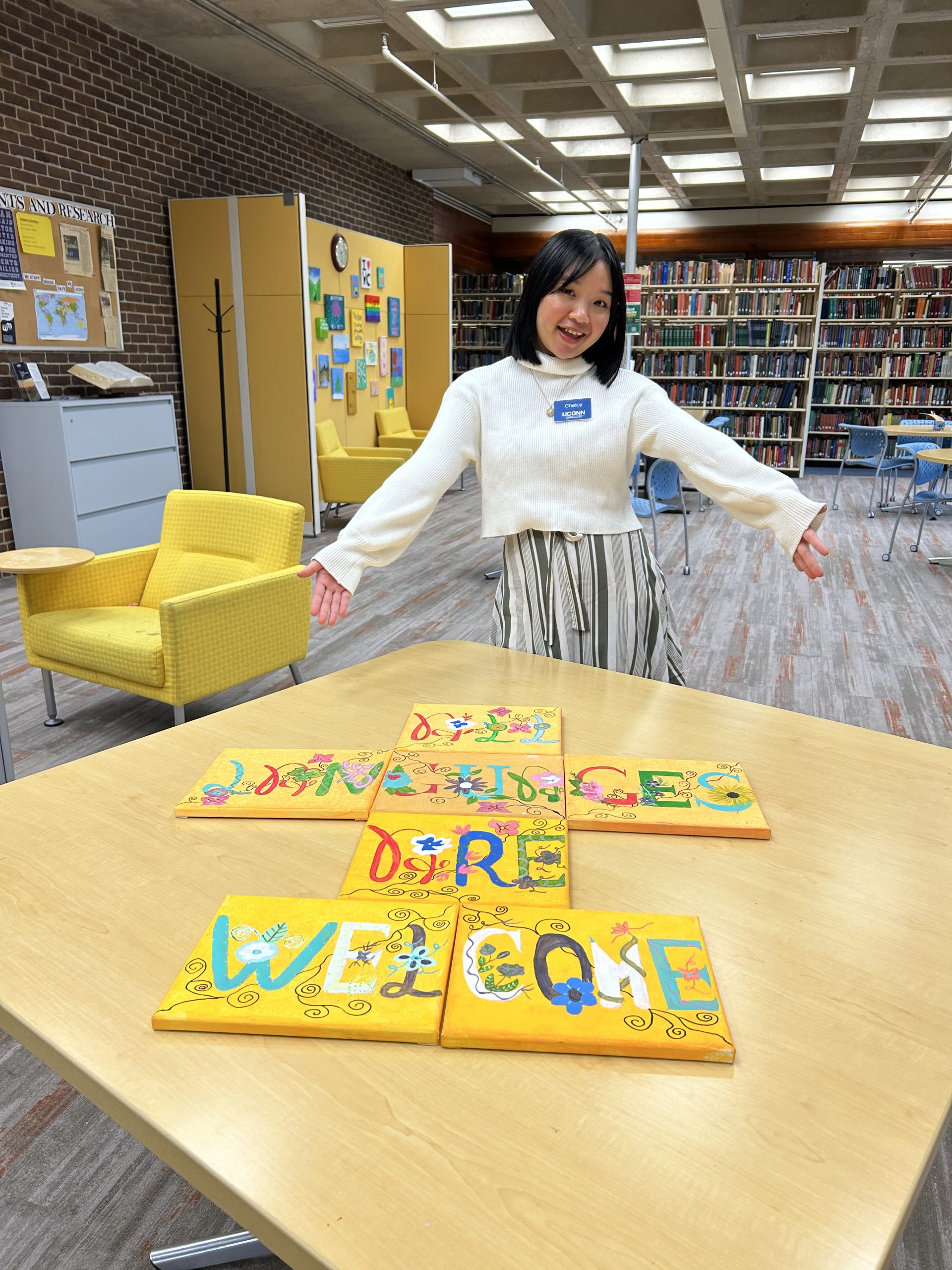
By embracing the concept of radical writing centers, we expanded our tutoring practices to not just welcome or accommodate writers in languages other than English but to encourage writing and speaking in all languages. We began this work in similar ways to other centers—working to train our tutors to be better prepared to work with a variety of writers, engaging with faculty, and encouraging more awareness of the needs and experiences and value of multilingual writing. But to truly begin making changes, the administrators made the conscious decision to increase the audibility of languages other than English through our coffee hour, through speaking our languages and language varieties, and even through the small rhetorical move to use Spanish to begin our 2023 NEWCA presentation in New Hampshire. In truth, while there is value to what is visible, signs and website statements can be more easily ignored—in our own center, these visual components are often passed over by those who do not already value multilingualism—but every time we speak out loud in a language other than English, people turn. Being audibly confronted with languages other than English allows both monolingual and multilingual learners to challenge their preconceptions on languages that should and can exist in academia.
We firmly believe that writing centers can and should play a crucial role in promoting multilingualism and linguistic justice on university campuses. By advocating for the recognition and celebration of all languages, we contribute to creating a more inclusive and egalitarian image of multilingualism in the United States.
While there are many actions needed to continue our work to create a more linguistically diverse and welcoming environment in the writing center and beyond, the focus of our efforts will be on strengthening our relationship with faculty and administrators. As the primary point of contact for many university students, it is vital to ensure these individuals are informed on our efforts to radicalize the writing center and strengthen the community we are building. Additionally, we would like to assess our efforts beyond the sizable interest in our events to track the number of visiting and returning international and (self-proclaimed) multilingual students as well as the number of multilingual tutors willing and comfortable stepping forward to tutor in their languages and language varieties.
Ultimately, our journey thus far is a testament to the power of challenging established norms in advocating for linguistic equity. By valuing and embracing all languages, we take a step towards dismantling linguistic imperialism and creating a more inclusive and just academic community, not to mention a community that is genuinely welcoming to all learners at our university. We encourage writing centers across the country to join us in this endeavor and to share their own initiatives with us, working to further promote the richness of multilingualism and celebrate the voices of all writers.
Translation of Margaret’s reflective narrative
Lizzette Irizarry, at the time an undergraduate tutor, and I had begun conversing in Spanish when I overheard her and requested to engage with her in Spanish sometimes, given how I loved the language. She happily agreed, citing her initial discomfort with using it in public academic spaces but her genuine love of using the language with anyone who was familiar. As the conversation progressed, she mentioned her honors research was geared towards a study of bilingual students and bilingual education. Upon my suggestion that she integrate both languages in a study such as this one, especially if she planned to include any narrative components, she excitedly agreed, but immediately second guessed whether or not her thesis committee would allow or welcome this. To me, this apprehension was disheartening– given the focus of her writing and her identity as a bilingual writer, it only made sense that she should be allowed to use both languages (spoiler: they let her do so).
Translation of Robert’s reflective narrative
When I started working at the writing center, I realised that there were people who spoke other languages, which I was fluent in as well. In particular, there were several Spanish speakers and a German-speaking tutor. As I was fluent in both languages, I started speaking to my new colleagues in Spanish and German. At first they were not entirely comfortable, but over time they gained confidence and we established a daily practice of communicating in languages other than English. However, the most interesting thing was not only to establish oral communication, but also written communication.
I remember the first email I sent to Lizzette Irizarry, one of our Spanish-speaking tutors. Since we always communicated in Spanish, I decided to send her email in that same language, since it seemed the most logical and natural thing to do. However, for her, receiving this email was something significant and empowering, since it was the first time that Lizzette had received a written communication, of a professional and academic nature, in Spanish, which for her was a home and family language.
Notes
-
- [1] English translation available in an endnote. Phrases in Spanish and English are intentionally inexact. As many language learners and as an English-dominant Spanish learner, Margaret chose to use the terms she was most familiar with in each language, maintaining similar meaning within the constraints of her language comfortability, without using outside sources to ensure a direct translation. For her, this is a genuine representation of her ideas in both languages.
- [2] Give me your tongue.
- [3] Where Colombians and foreigners can meet and enjoy good food, and at the same time engage into an exchange of knowledge and experiences.
References
Adler-Kassner, L., & Wardle, E. A. (Eds.). (2015). Naming what we know: Threshold concepts of writing studies. Utah State University Press.
Álvarez Valencia, J. A., & Miranda, N. (2022). Indigenous students’ agency vis-à-vis the practices of recognition and invisibilization in a multilingual university. Teaching in Higher Education, 27(4), 470–488. https://doi.org/10.1080/13562517.2022.2053952
Anderson, S. (2020). Tutors’ and multilingual writers’ narrative framing of writing center visits: Attention to grammar. INTESOL Journal, 17(1). https://doi.org/10.18060/24417
Audible. (n.d.). In Cambridge Dictionary. Cambridge University Press. https://dictionary.cambridge.org/dictionary/english/audible
Baker-Bell, A. (2020). Linguistic justice: Black language, literacy, identity, and pedagogy (1st ed.). Routledge. https://doi-org.ezproxy.lib.uconn.edu/10.4324/9781315147383
Basta, H. (2020). The multilingual turn in a tutor education course: Using threshold concepts and reflective portfolios. Discourse and Writing/Rédactologie, 30, 237–257. https://doi.org/10.31468/cjsdwr.807
Beaudrie, S. (2023). Developing critical language awareness in the heritage language classroom: Implementation and assessment in diverse educational contexts. Languages, 8(1), 81. https://doi.org/10.3390/languages8010081
Bialystok, E., & Viswanathan, M. (2009). Components of executive control with advantages for bilingual children in two cultures. Cognition, 112(3), 494–500. https://doi.org/10.1016/j.cognition.2009.06.014
Blazer, S., & Fallon, B. (2020). Changing conditions for multilingual writers. Composition Forum, 44. https://compositionforum.com/issue/44/changing-conditions.php
Cirillo-McCarthy, E., Del Russo, C., & Leahy, E. (2016). ‘We don’t do that here’: Calling out deficit discourse in the writing center to reframe multilingual graduate support. Praxis: A Writing Center Journal, 14(1).
Condon, F. (2007). Beyond the known: Writing centers and the work of anti-Rracism. Writing Center Journal, 27(2). https://doi.org/10.7771/2832-9414.1628
Conversations from the Margins. (2021). University of Connecticut. https://ritm.initiative.uconn.edu/narratives/
De Vito, C. D. (2020). Knowledge and power: The languages of academia. WORCK (Worlds of Related Coercions in Work). https://worck.eu/2021/11/05/knowledge-and-power-the-languages-of-academia/
DeContacto (Director). (2016, November 11). Ven al centro y dame tu lengua. Youtube. https://www.youtube.com/watch?v=CiwY3kZPK94
Del Russo, C., & Krishnamurthy, S. (2020). Shifting the center: Towards an ehos and practice of social justice. The Peer Review. https://thepeerreview-iwca.org/issues/issue-4-2/shifting-the-center-towards-an-ethos-and-practice-of-social-justice/
Fitzgerald, L. (2006). The idea of a writing center community. Writing Center Journal, 26(1). https://doi.org/10.7771/2832-9414.1591
Franks, S. (2019, March 4). America’s failure to fund language education Is creating a crisis. https://blog.languageline.com/americas-failure-to-fund-language-education-is-creating-a-crisis
Frascatore, J. (2021, November 6). The racist stigmas in the phrase “speak English, this is America”. Medium. https://jayson-frascatore.medium.com/the-racist-stigmas-in-the-phrase-speak-english-this-is-america-b461a7439357
Gration, E. (2021, November 9). Bilingualism statistics in 2022: US, UK & global. https://preply.com/en/blog/bilingualism-statistics/
Greenfield, L. (2019). Radical writing center praxis: A paradigm for ethical political engagement. Utah State University Press.
Greenfield, L., & Rowan, K. (Eds.). (2011). Writing centers and the new racism: A call for sustainable dialogue and change. Utah State University Press. https://doi.org/10.2307/j.ctt4cgk6s
Grimm, N. M. (2011). Retheorising writing center work to transform a system of advantage based on race. In L. Greenfield & K. Rowan (Eds.), Writing Centers and the New Racism: A Call for Sustainable Dialogue and Change (pp. 75–100). University Press of Colorado. https://doi.org/10.2307/j.ctt4cgk6s.8
Gyenes, A. (2016). Conspicuous internationalization? Creating an “international communication lounge” on a Japanese university campus. IAFOR Journal of Education, 4(2). https://doi.org/10.22492/ije.4.2.06
Kail, H., & Trimbur, J. (1987). The politics of peer tutoring. WPA: Writing Program Administration, 11(1–2).
Herlihy-Mera, J. (2022). A case for multilingual universities. Inside Higher Ed. https://www.insidehighered.com/views/2022/05/19/multilingual-university-model-brings-benefits-opinion
Hopwood, S. P. (2018, August 30). Is the lack of foreign language skills hurting Americans? Day Translations Blog. https://www.daytranslations.com/blog/lack-language-skills-hurts-americans/
Horner, B., & Trimbur, J. (2002). English only and U.S. college composition. College Composition and Communication, 53(4), 594. https://doi.org/10.2307/1512118
Jasim, Y. (2021). Benefits of learning a second language. SSRN Electronic Journal. https://doi.org/10.2139/ssrn.3895362
Kroll, J. F., & Dussias, P. E. (2017). The benefits of multilingualism to the personal and professional development of residents of the US. Foreign Language Annals, 50(2), 248–259. https://doi.org/10.1111/flan.12271
Lape, N. (2019). From English-centric to multilingual: The Norman M. Eberly Multilingual Writing Center at Dickinson College. Composition Forum, 41. https://files.eric.ed.gov/fulltext/EJ1213665.pdf
Lee, T., & Molina, L. E. (2021). “If you don’t speak English, I can’t understand you!”: Exposure to Various Foreign Languages as a Threat. Social Sciences, 10(8), 308. https://doi.org/10.3390/socsci10080308
Leki, I. (2009). Before the conversation: A sketch of some possible backgrounds, experiences, and attitudes among ESL students visiting a writing center. In ESL writers: A guide for writing center tutors (pp. 1–17). Boynton/Cook.
Lorimer Leonard, R., Bruce, S., & Vinyard, D. (2021). Finding complexity in language identity surveys. Journal of Language, Identity & Education, 22(2), 167–180. https://doi.org/10.1080/15348458.2020.1863152
Matsuda, A., & Matsuda, P. K. (2010). World Englishes and the teaching of writing. TESOL Quarterly, 44(2), 369–374. https://doi.org/10.5054/tq.2010.222222
Matsuda, P. K., & Cox, M. (2011). Reading an ESL writer’s text. Studies in Self-Access Learning Journal, 2(1), 4–14. https://doi.org/10.37237/020102
Mesthrie, R., & Bhatt, R. M. (2008). World Englishes: The study of new linguistic varieties. Cambridge University Press.
Miller, J. (1999). Becoming audible: Social identity and second language use. Journal of Intercultural Studies, 20(2), 149–165. https://doi.org/10.1080/07256868.1999.9963477
Otheguy, R., García, O., & Reid, W. (2015). Clarifying translanguaging and deconstructing named languages: A perspective from linguistics. Applied Linguistics Review, 6(3), 281–307. https://doi.org/10.1515/applirev-2015-0014
Phillipson, R. (1992). Linguistic imperialism. Oxford University Press.
Summers, S. (2020). Developing translingual dispositions to negotiate gatekeeping in the graduate writing center. In A. Frost, J. Kiernan, & S. Blum-Malley (Eds.), Translingual Dispositions: Globalized Approaches to the Teaching of Writing (pp. 249–268). The WAC Clearinghouse. https://doi.org/10.37514/INT-B.2020.0438.2.11
Snyder, S., Staehr Fenner, D., Smith, S., & Singh, J. (2023). Terminology to describe multilingual learners: Labels and their implications. SupportEd.
Van Parijs, P. (2002). Linguistic justice. Politics, Philosophy & Economics, 1(1), 59–74. https://doi.org/10.1177/1470594X02001001003
Van Parijs, P. (2011). Linguistic justice for Europe and for the world. Oxford University Press. https://doi.org/10.1093/acprof:osobl/9780199208876.001.0001
Vieira, K. (2017, August 24). An introduction to multilingual writers at UW-Madison. Writing Across the Curriculum. https://dept.writing.wisc.edu/wac/an-introduction-to-multilingual-writers-at-uw-madison/
Voloshko, V. (2023, February 5). The transformative power of learning a foreign language. https://www.successconsciousness.com/blog/studying/transformative-power-of-learning-a-foreign-language/
Wang, Z. (2018). Rethinking translingual as a transdisciplinary rhetoric: Broadening the dialogic space. Composition Forum, 40.
Young, V. A. (2010). Should writers use they own English? Iowa Journal of Cultural Studies, 12(1), 110–117. https://doi.org/10.17077/2168-569X.1095
Zatryb, R. (2023, March 7). I’m so sorry, English is not my first language – Another Word [University of Wisconsin-Madison]. Another Word. https://dept.writing.wisc.edu/blog/im-so-sorry/
Zimmerelli, L. (2015). A place to begin: Service-learning tutor education and writing center social justice. Writing Center Journal, 35(1). https://doi.org/10.7771/2832-9414.1797